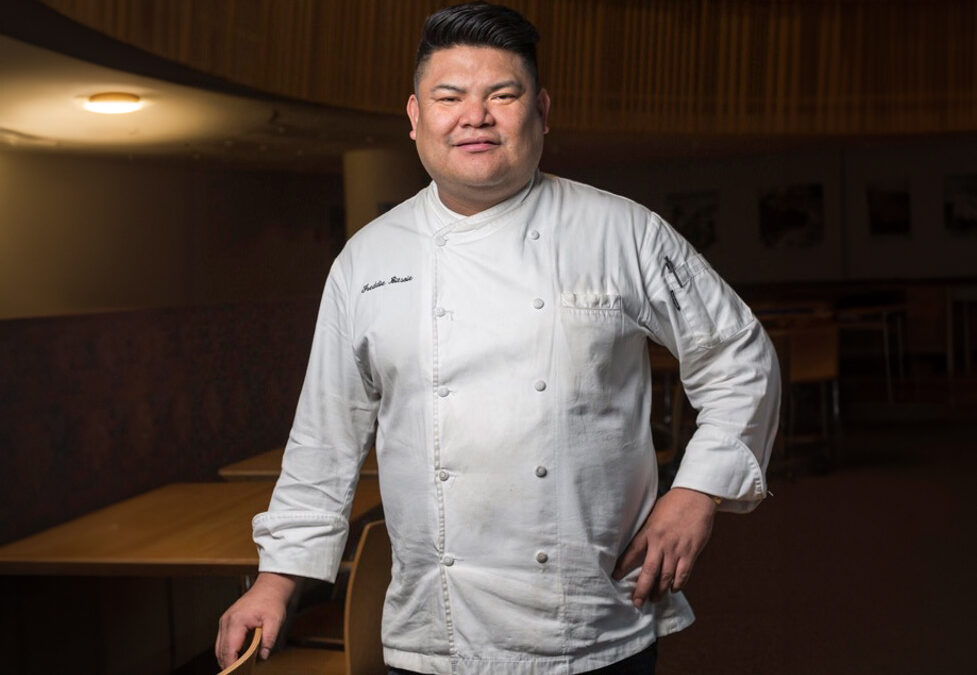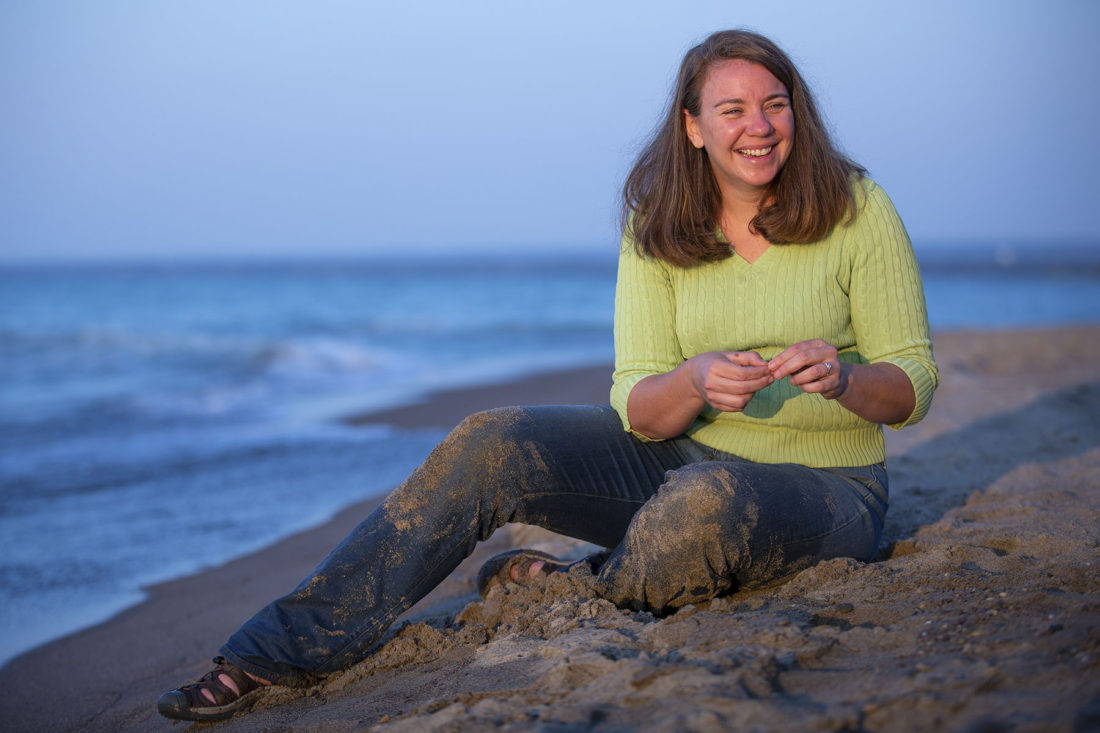Chef Freddie Bitsoie, Navajo Chef and Author
We recently caught up with Freddie J. Bitsoie, renowned Diné (Navajo) chef and author, over a quintessential scoop of chocolate ice cream at Berkey Creamery. Chef Freddie visited Penn State Sustainability from November 2nd – November 9th for a series of events held throughout the campus and community including speaking engagements, an appearance at the Centre Film Festival, and cooking demonstrations.
Celebrated for his modernization of Native cuisine, Chef Freddie’s journey began amidst the landscapes of Utah and extended through Albuquerque’s Sandia Mountains and California. Initially pursuing cultural anthropology at the University of Mexico, a conversation with an archaeology professor led him to the culinary arts. He pursued mastery at Le Cordon Bleu in Scottsdale, Arizona, and soon became a distinguished figure on the Food Network and at the Mitsitam Native Foods café, where he serves as the Executive Chef within the National Museum of the American Indian. In 2021, Chef Freddie published the cookbook New Native Kitchens, which showcases the variety of flavor and culinary history on offer from coast to coast, providing modern interpretations of 100 recipes that have long fed this country.
Can you share the story of your journey from cultural anthropology to the culinary arts? What inspired this professional transition?
I grew up as a natural anthropologist. It was a truth that I observed, beginning at a very young age, that distance can create huge differences in people even if they are a part of the same culture. When you grow up in a rural area, it’s very noticeable. When I grew up and got to go to college, it was through my formal studies of anthropology that I began to understand that there was terminology for the observations I’d been making throughout my life. After enjoying one of my initial classes, I then started a minor in art history. That class allowed me to view the world’s history from a completely different perspective than I’d previously conceived. America’s overall culture tends to think of the history of the world through a very rudimentary lens: Western Civilization 101. I took these classes and began understanding the world differently than many of my peers.
I appreciate that art history taught me how to discuss world history without being nonpolitical. At that moment, I hadn’t considered going into the culinary arts. After speaking to one of my anthropology instructors, he convinced me to study food in some capacity. We talked about Mesopotamian and Roman food cultures because my interest anthropologically was seeing when and who was historically focused on the craft of cooking rather than strictly eating for sustenance.
When most people envision Native Americans in the past, they imagine that we killed an animal or gathered some berries and just ate it without any real craft to our cooking. What’s left out of that story is the tradition of creating cultural dishes and the communal capacity in which we share with one another. I know it wasn’t as reductionary as some imagine it. Food has a history. To delve into that, I like looking at how cultural foods spread geographically – not just east to west from France and Germany, but holistically, from north to south and south to north.
What key aspects of your cultural background have influenced your approach to modernizing Native American cuisine?
I think my culture is very coarse. People tend to view it as more disassociating, but when we spend time together communally, and as a family, it’s deeply embedded in our culture to share a lot. There’s a lot of care in that. When I explain Native Food, it has much to do with sharing and understanding each other and appreciating where the food comes from. I have never met a Navajo elder who has denied someone food for any reason, even if they were enemies. My Mom tells a story about a family living about a half mile away from my grandmother, who was constantly at odds with our family. But when it came time to butcher a sheep, my grandma always gave that family a share of the lamb. It inspires me because I’m not naturally inclined to be that giving.
In your book “New Native Kitchen,” you explore innovative approaches to Native American cuisine. Could you highlight some fundamental principles or techniques you emphasize in your work?
There’s a cooking technique that Native people use called “steeping.” Well, I call it steeping, at least.
In French cuisine, we build soups. That’s what it’s called because it comes together in layers. You have your sweating, aromatics, the protein, if there is one, the main ingredient, and then the stock. So, it has layers, and each layer has seasoning on it.
In contrast, with Native food, everything is put in one pot over low heat. There’s never any boiling involved. All the flavors come together slowly, and the soup will cook for about 3-4 hours.
French soups are pretty much done in 45 minutes tops, but with Native foods, everything is collectively flavored. If you make a Navajo mutton soup the French way, it will taste completely different, even though the ingredients are the same. My Mom hates it when I make French soups, especially when she’s in the mood for something hearty and homey.
How would you describe the importance of sustainability to you personally, and how does it relate to your work with Indigenous culinary traditions?
It doesn’t naturally. It’s honestly forced culturally. Native people are often stereotyped as stewards of the land. It’s almost romanticized that we must fill this role, and if we don’t, we’re “bad natives.” So, I think sustainability is not naturally geared more towards Native culture than any other.
In the food industry, French or Italian culinary traditions have no pressure or obligation to have a minimal carbon footprint. You could ship ingredients in from big companies, but with Native food, there’s an unspoken expectation to have a local farm and to publicize that we care about the land.
I don’t mind operating sustainably, but often it’s not possible. I have a significant carbon footprint because I travel all over the country. I drive everywhere because it’s necessary for me to run my business.
When I worked at the museum in Washington D.C., one of the most in-demand dishes had Cholla Buds as a staple ingredient. Cholla Buds do not grow in the northeast, so that ingredient was unavailable locally, and we had to ship it from Arizona. Similar things happened with Alaskan Salmon.
There’s an argument between what ingredients are authentic and what is true to the culture. People want this authentic concept of what Native food is, but because our People are geographically widespread, there’s a lot of food that might not be available in one region but is still Native.
It takes a lot to move it around, and on top of that, there is no industry. It’s grandmas and aunts who are picking these ingredients, harvesting them, and selling them at local markets or roadside stands. For me to get them, I must drive long distances. That’s the balance between supporting the cuisine and incorporating authentic traditional ingredients in these dishes and compensating fairly and harvesting without damaging the earth.
Could you talk a little bit more about the perception of Native food as a homogenous foodway rather than one with regional specialties and identifiable tribal variances?
We must consider that when we call something Native American Cuisine, that doesn’t mean anything. We have the Seminole tribe. That’s Native American. We have the Navajo tribe. That’s Native American. We have the Tlingit tribe. That’s Native American. We’re all grouped together, but one lives in Florida, one lives in the Pacific Northwest, and the other lives in the Southwest.
So, we must start looking at it from a more regional aspect. Whether we do a large region like the Pacific Northwest, the Southwest, the Southeast, the Northeast, or we could do, for example, the Colorado Plateau, which is where the Four Corners are. The tribes on the Colorado Plateau would be the Hopi, Navajo, Apache, and Zuni tribes because they all belong to that region. When discussing Indigenous foods, the foods that shape a specific region are hyper-local. They aren’t grown anywhere else in the world other than, you know, the Four Corners, or Phoenix, or Washington State, or Florida.
In Florida specifically, you have swamp cabbage, which is a local name for “hearts of palm.” In the past, hearts of palm were such a high-demand food that it has since become a protected plant, and it is currently illegal to harvest. This type of law has a ripple effect, disconnecting tribal relations with locally available foods. These regionalities are essential parts of how people identify themselves through the ingredients.
Could you talk a little more about the perception of how food has spread to new areas? You mentioned the east to west transition where foods came from France and Germany, but that outlook, while commonly held, is a rather Eurocentric view of how food arrived in the “New World”. What are people missing?
Generally, when we talk about food history, we’re very Eurocentric. We tend to think that everything started in the east and spread Westwards. However, when it comes to food history, the food culture started with Iberian culture. When the Iberians colonized modern-day Central Mexico, they changed the existing food culture. They moved north of the middle part of the continent into modern-day Northern Mexico, Arizona, New Mexico, and Utah. So, the food knowledge they had was spreading with them. That’s how I view the history of the world. On top of that, French culture, when they arrived in what is now Canada, their food culture spread from north to south. So, when we look at this all happening in tandem, the Americas were swallowed by French, Spanish, and Iberian-inspired cooking traditions.
With the Canadian and Mexican governments, for the most part, they would let their cultures eat what they wanted to, and there was little relocation among their citizens. The problem is with the United States government, there was a purposeful eradication of culture, people, and groups. There was a no-holds-barred, “get those Natives out of here” attitude.
As a result, we Natives are now reforming and reshaping our culinary history. These are some things I examine regarding Native food history because, for most Native chefs, our job is to look back. I heard this term yesterday; it’s called “reaching back.” You metaphorically reach back to see if you can find a particular history that can be relearned and shared again. That is fundamentally most important.
I want to add that we often think about this like its ancient history – the conquistadors in the 1400s. However, the first residential boarding school in America, the Carlisle Indian Industrial School, began operation in 1879 and ran for 39 years. It affected thousands of Indigenous families from over 140 tribes. That’s right down the road and is well within generational history. The cultural eradication that you mentioned and the trauma that comes with it are not that far away. It’s recent.
When I was in high school, there was a trend where Navajo kids found it embarrassing to be Navajo. Everybody, for lack of a better term, wanted to be white. My parents didn’t teach us to speak Navajo because they had been forcibly forbidden from speaking it themselves.
I tell this joke that if people closed their eyes and heard me talk, they would think I was the whitest guy in America. But there’s a reason why. It was dangerous not to assimilate. The generational connection between loss of culture is not that far away. My parents were in boarding schools in the late 60s, and their relatives were in boarding schools in the 40s and 50s. It’s not that far away and is inextricably intertwined with modern-day culture.
The best way I have found to tell our history is through the culinary arts because that’s what I’m working to rediscover. Food studies are reconnecting me with my culture, and as much as I want to deny it because, as an anthropologist, I am supposed to view the world objectively, it is helping me identify where I see myself fitting within that.
How does cooking and sharing traditional Native American recipes contribute to cultural preservation and celebrating your heritage?
That question answers itself because it’s not just valid for Native food; it’s for all food. My job focuses on Native cuisine, but cuisine, whether French, English, Italian, Asian, or North African, all have a story and a culture.
You know there’s a reason why Moroccan and Indian foods are heavily spiced; it all has to do with the hot climate and the ability to refrigerate. Heavily spiced and spicy foods prevent spoilage because bacteria and foodborne pathogens can’t survive in the environment. Many herbs and ingredients relied upon in those areas are naturally anti-bacterial, like onions, garlic, allspice, and oregano. Capsicum is what makes chilies and other hot peppers taste hot. It can kill or inhibit up to 75% of bacteria.
Similarly with Kosher foods, shellfish goes bad quickly, and food poisoning can make you very ill. So, the best way to promote food safety became to embed it within people’s belief systems. It’s not just for excluding foods but also for integrating them. In Indigenous culture, sheep are not indigenous to the Southwest, but for some peculiar reason, Navajo people love to eat sheep. Zuni people, some Pueblos, enjoy it regularly. That happened because the Iberians had a culture of domesticating agricultural animals – mainly sheep and goats, rather than hunting wildlife. The truth is that the Navajos picked this up as they encountered the Iberians, but the cultural story passed down is that one day, a massive fog came down and lasted for four days and nights. When the fog was lifted, it left behind little puffs of the clouds, the sheep. And so, in a way, sheep are like food from Heaven—a divine intervention.
Having these types of origin stories allows cultures to integrate or exclude new foods from their diets. Making belief a part of your eating is a compelling thing. We are the products of our ancestors, and we still consciously or unconsciously believe much of what they’ve taught us about what foods we should or should not eat.
Are there any foods in your diet that result from your cultural belief systems?
I was told that the ice cream here at the Creamery is an institution in and of itself and is almost thought of as a religion! I like it. It’s always a pleasure to come back to Penn State. I love the environment here. It’s great. It’s a great place to be. The ice cream is good.
Jokes aside, cactus is one. Navajos are not allowed to eat cacti, but I like it, you know. I think there are only two fundamental reasons people don’t eat certain foods. Either the first time they ate the food, it was poorly cooked, or they had a bad experience with it. Other than that, when it comes to religious and cultural beliefs, I don’t argue against those reasons because I’d rather not try to change people’s beliefs unless they choose to.
You mentioned earlier that there are misconceptions about Indigenous food and how sustainable it is presented to be, regardless of whether that’s true. Is there anything you’d like to see changed about that representation?
What is sustainability? What does that mean to the average person who has a job, goes to work from 8-5, has to stop at a supermarket, eats fast food, and then goes home? For example, when I lived in Washington, the culture was to drive to work rather than take the metro, even though the metro was a faster commute. People would rather sit in their cars for two hours than make the more sustainable choice.
I sense that people, in general, need to be more aware of their surroundings and environment and how their collective habits contribute to this issue.
It’s challenging to steer people away from what they want to eat and the lengths they’ll traverse to get it. Shipping ingredients from Canada, France, or Italy is unsustainable. There’s no way around that. People need to understand their impacts. I shared earlier about how Native foods have a massively different flavor depending on your region because the availability of the ingredients incorporated is hyper-dependent on your locality. Because people don’t understand the variances in Native cuisines and have inaccurately melded us into this homogenous group, they have unrealistic expectations about what Indigenous food really is. It’s a space where more awareness of how food is acquired and distributed now would shape people’s understanding of “sustainable foods” overall.
It’s no secret that food has a reputation as being a cultural unifier. As a contributor to the Indigenous culinary field, what do you hope to achieve through your work, and what impact do you aspire to make in the future?
I hope to answer my own questions. My question is, “What is Native American cuisine, and how do we define it?”. Because saying “Native American cuisine” does nothing to expand people’s perception of what that is. Regardless of how much work I do, that will always be a term that lingers in the cultural lexicon. Instead of fighting it, let’s work to find a standard definition for it.
If you ask ten people on the street what Native American cuisine is, there will be ten different answers. But Native American is anything indigenous to the Western Hemisphere. That’s widely diverse. That’s what I want to figure out. Do we examine this culturally? By looking at indigenous plants or animals? I want to figure out a way to explain it succinctly without talking for two paragraphs, you know?
If you were going to recommend one recipe from your cookbook for Penn Staters to try to make for themselves this fall, which would it be?
The stewed chicken with golden tomatoes. It’s my absolute favorite because my grandma used to make it. I always thought it was so good. I assumed it was a Navajo dish, but when I went to culinary school, we made the same dish, and it turned out it was chicken cacciatore!
I changed the recipe a little from my grandma’s by modernizing it. I like the flavor of wine in a stew. So, there’s wine in there, there’s some garlic in there. Grandma would have just put everything in a pot and turned on the thing. It generally tastes the same, but it’s not an original. Nothing is. There is no such thing as an original dish. She must have been taught this dish by friends at her church or through some other type of cultural diffusion. It’s a classic.






